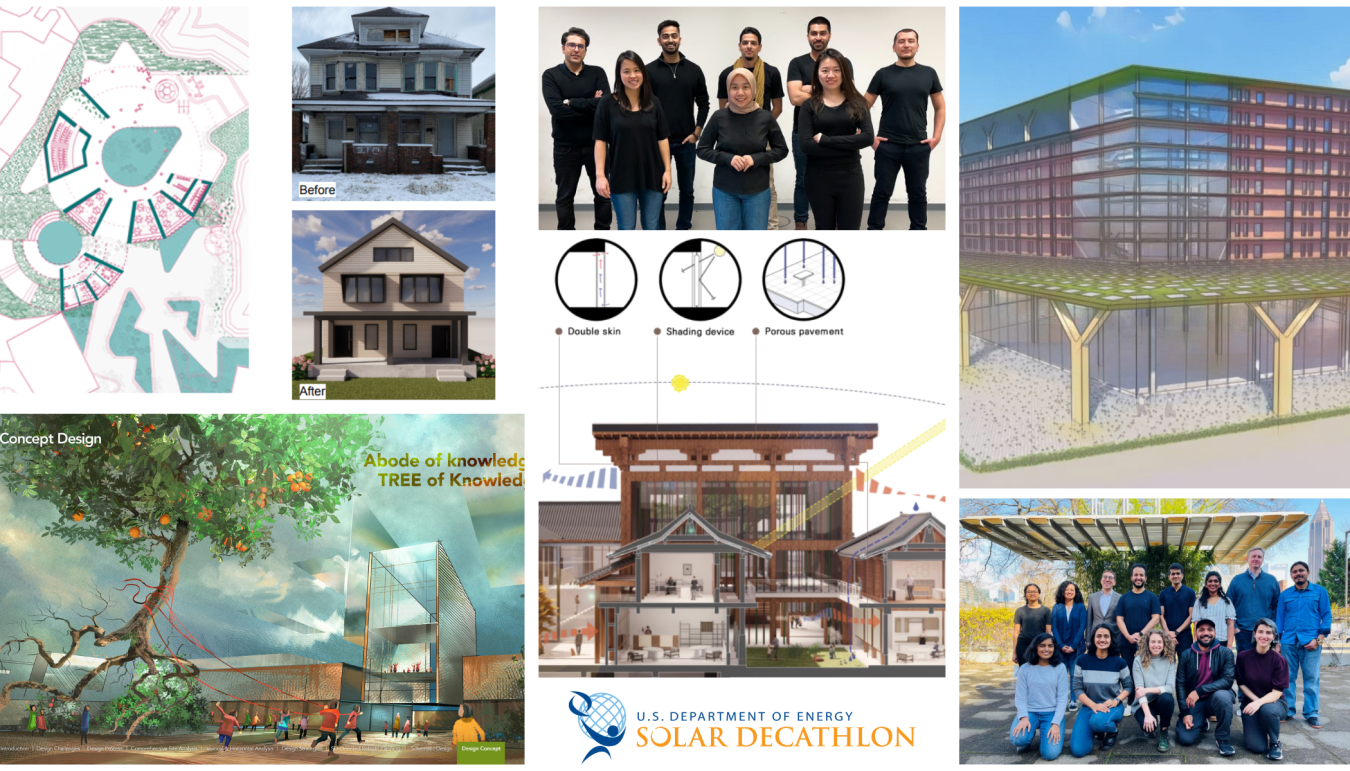Fifty-five teams representing 38 universities are advancing as finalists in the U.S. Department of Energy Solar Decathlon® 2022 Design Challenge.
Office of Critical Minerals and Energy Innovation
March 1, 2022
Fifty-five teams representing 38 universities are advancing as finalists in the U.S. Department of Energy Solar Decathlon® 2022 Design Challenge.
Finalist teams were chosen based on presentations and design submissions at the semifinal competition event, held virtually February 25–26, 2022. During this event, teams pitched their unique building designs, impressing industry expert jurors with their creativity and ability to tackle the most difficult issues in the built environment.
Up to 10 teams per division were selected as finalists, with divisions spanning the following residential and commercial building types: New Housing, Retrofit Housing, Attached Housing, Multifamily Building, Office Building, and Education Building.
Finalist teams will compete in the Solar Decathlon Competition Event, April 22–24, 2022, at the National Renewable Energy Laboratory in Golden, Colorado. Additionally, there will be virtual participation available. First place winners will be chosen in each division with one grand winner selected in each of the residential and commercial categories.
Congratulations to the 55 finalist teams advancing to the final round of the 2022 Design Challenge from 38 collegiate institutions.
New Housing Division
- Ball State University, Muncie, Indiana
- Ferris State University, Big Rapids, Michigan
- Tennessee State University, Nashville, Tennessee
- The University of Arizona, Tucson, Arizona
- The University of Tennessee at Chattanooga, Chattanooga, Tennessee
- University of Alaska Fairbanks, Fairbanks, Alaska
- University of Central Florida, Orlando, Florida
- University of Technology Sydney, Ultimo, Australia
- University of Victoria, Victoria, British Columbia
- University of Wisconsin-Madison, Madison, Wisconsin; University of Wisconsin-Milwaukee, Milwaukee, Wisconsin
Retrofit Housing Division
- Ball State University, Muncie, Indiana
- Ferris State University, Big Rapids, Michigan
- Georgia Institute of Technology, Atlanta, Georgia
- Illinois Institute of Technology, Chicago, Illinois
- The Pennsylvania State University, State College, Pennsylvania
- University of Canterbury, Christchurch, New Zealand
Attached Housing Division
- Ball State University, Muncie, Indiana
- Ferris State University, Big Rapids, Michigan
- Kansas State University, Manhattan, Kansas
- Ryerson University, Toronto, Ontario
- The University of Arizona, Tucson, Arizona
- The University of Texas at Austin, Austin, Texas
- University of California Los Angeles, Los Angeles, California
- University of Central Florida, Orlando, Florida
- University of Missouri, Columbia, Missouri
- Wentworth Institute of Technology, Boston, Massachusetts
Multifamily Building Division
- Northwestern University, Evanston, Illinois
- Ryerson University, Toronto, Ontario
- The Cooper Union for the Advancement of Science and Art, New York City, New York
- Technische Universität Berlin, Berlin, Germany
- The University of Arizona, Tucson, Arizona
- University of Cincinnati, Cincinnati, Ohio
- University of Illinois Urbana-Champaign, Urbana, Illinois
- University of Missouri, Columbia, Missouri
- University of North Texas, Denton, Texas
- Wentworth Institute of Technology, Boston, Massachusetts
Office Building Division
- Ball State University, Muncie, Indiana
- Howard University, Washington, D.C.
- Jackson State University, Jackson, Mississippi
- Myongji University (명지대학교), Seoul, South Korea
- Pennsylvania College of Technology, Williamsport, Pennsylvania
- Ryerson University, Toronto, Ontario
- Tehran University of Art (دانشگاه هنر تهران), Tehran, Iran
- Thomas Jefferson University, Philadelphia, Pennsylvania
- University of Cincinnati, Cincinnati, Ohio
- Wentworth Institute of Technology, Boston, Massachusetts
Education Building Division
- Ball State University, Muncie, Indiana
- Carleton University, Ottawa, Ontario
- Ryerson University, Toronto, Ontario
- Shiraz University (انشگاه شیراز), Shiraz, Iran
- Thomas Jefferson University, Philadelphia, Pennsylvania
- Universidad Nacional Autónoma de México, Mexico City, Mexico
- University of Cincinnati, Cincinnati, Ohio
- University of Oregon, Eugene, Oregon
- Virginia Polytechnic Institute and State University, Alexandria, Virginia
About the Solar Decathlon
The U.S. Department of Energy Solar Decathlon® is a collegiate competition that prepares the next generation of building professionals to design and build high-performance, low-carbon buildings powered by renewables. The Design Challenge is a one- to two-semester, design-only competition, while the Build Challenge is a two-year design-build competition.
Celebrating its 20th anniversary in 2022, the Solar Decathlon has challenged more than 25,000 students to create efficient, affordable buildings powered by renewables, while promoting student innovation, STEM education, and workforce development opportunities in the buildings industry.
Buildings account for 75% of electricity use, 40% of total energy use, and 35% of carbon emissions in the United States. Solar Decathlon supports a key strategy for tackling climate challenges: developing a workforce that is equipped to design and construct a low-carbon building stock and deliver an equitable energy future.
Additional details are available on the Solar Decathlon website.
About EERE
The mission of DOE’s Office of Energy Efficiency and Renewable Energy is to accelerate the research, development, demonstration, and deployment of technologies and solutions to equitably transition America to net zero greenhouse gas emissions economy-wide by no later than 2050, and ensure the energy economy benefits all Americans, creating good paying jobs for the American people—especially workers and communities impacted by the energy transition and those historically underserved by the energy system and overburdened by pollution.

